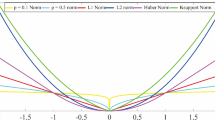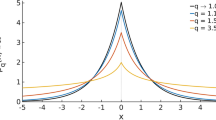Abstract
Seismic full waveform inversion (FWI) has primarily been based on a least-squares optimization problem for data residuals. However, the least-squares objective function can suffer from its weakness and sensitivity to noise. There have been numerous studies to enhance the robustness of FWI by using robust objective functions, such as l 1-norm-based objective functions. However, the l 1-norm can suffer from a singularity problem when the residual wavefield is very close to zero. Recently, Student’s t distribution has been applied to acoustic FWI to give reasonable results for noisy data. Student’s t distribution has an overdispersed density function compared with the normal distribution, and is thus useful for data with outliers. In this study, we investigate the feasibility of Student’s t distribution for elastic FWI by comparing its basic properties with those of the l 2-norm and l 1-norm objective functions and by applying the three methods to noisy data. Our experiments show that the l 2-norm is sensitive to noise, whereas the l 1-norm and Student’s t distribution objective functions give relatively stable and reasonable results for noisy data. When noise patterns are complicated, i.e., due to a combination of missing traces, unexpected outliers, and random noise, FWI based on Student’s t distribution gives better results than l 1- and l 2-norm FWI. We also examine the application of simultaneous-source methods to acoustic FWI based on Student’s t distribution. Computing the expectation of the coefficients of gradient and crosstalk noise terms and plotting the signal-to-noise ratio with iteration, we were able to confirm that crosstalk noise is suppressed as the iteration progresses, even when simultaneous-source FWI is combined with Student’s t distribution. From our experiments, we conclude that FWI based on Student’s t distribution can retrieve subsurface material properties with less distortion from noise than l 1- and l 2-norm FWI, and the simultaneous-source method can be adopted to improve the computational efficiency of FWI based on Student’s t distribution.


















Similar content being viewed by others
References
Aravkin, A., Leeuwen, T. V., and Herrmann, F., 2011. Robust full-waveform inversion using the Student’s t-distribution, 81st Annual International Meeting, SEG, Expanded Abstracts, 30, 2669–2673.
Ben-Hadj-Ali, H., Operto, S., and Virieux, J., 2011, An efficient frequency-domain full waveform inversion method using simultaneous encoded sources, Geophysics, 76, R109–R124.
Blom, G., 1989, Probability and statistics: Theory and applications, Springer-Verlag.
Brossier, R., Operto, S., and Virieux, J., 2009, Seismic imaging of complex onshore structures by 2D elastic frequency-domain full-waveform inversion. Geophysics, 74, WCC105–WCC118.
Brossier, R., Operto, S., and Virieux, J., 2010, Which residual norm for robust elastic frequency-domain full waveform inversion?, Geophysics, 75, R37–R46.
Bube, K. P. and Langan, R. T., 1997, Hybrid l 1 /l 2 minimization with applications to tomography, Geophysics, 62, 1183–1195.
Choi, Y., Min, D.-J., and Shin, C., 2008, Two-dimensional waveform inversion of multi-component data in acoustic-elastic coupled media, Geophysical Prospecting, 56, 863–881.
Cohen, G., 2002, High-order numerical methods for transient wave equations, Springer.
Congdon, P., 2006. Bayesian statistical modelling: Second Edition, Wiley.
Costa, J. C., da Silva, F. J. C., Gomes, E. N. S., Schleicher, J., Melo, L. A., and Amezonas, D., 2008, Regularization in slope tomography, Geophysics, 73, VE39–VE47.
Crase, E., Pica, A., Noble, M., Mcdonald, J., and Trantola, A., 1990, Robust elastic nonlinear waveform inversion: application to real data, Geophysics, 55, 537–538.
Djikpesse, H. A. and Trantola, A., 1999, Multiparameter l 1 -norm waveform fitting: interpretation of Gulf of Mexico reflection seismogram, Geophysics, 64, 1023–1035.
Gholami, Y., Brossier, R., Prieux, V., Operto, S., Ribodetti, A., and Virieux, J., 2013a, Which parameterization is suitable for acoustic vertical transverse isotropic full waveform inversion? Part 1: Sensitivity and trade-off analysis, Geophysics, 78, R81–R105.
Gholami, Y., Brossier, R., Operto, S., Prieux, V., Ribodetti, A., and Virieux, J., 2013b, Which parameterization is suitable for acoustic vertical transverse isotropic full waveform inversion? Part 2: Synthetic and real data case studies from Valhall, Geophysics, 78, R107–R124.
Guitton, A., Ayeni, F., and Diaz, E., 2012, Constrained full waveform inversion by model reparameterization, Geophysics, 77, R117–R127.
Ha, T., Chung, W., and Shin, C., 2009. Waveform inversion using a back-propagation algorithm and a Huber function norm, Geophysics, 74, R15–R24.
Jackman, S., 2009. Bayesian Analysis for the Social Sciences: 2009, Wiley, West Sussex, UK.
Jeong, W., Min, D.-J., Lee, G., and Lee, H.-Y., 2011, 2D frequency-domain elastic full waveform inversion using finite-element method for VTI media. 81st Annual International Meeting, SEG, Expanded Abstracts, 30, 2654–2658.
Jeong, W., Lee, H.-Y., and Min, D.-J., 2012, Full waveform inversion strategy for density in the frequency domain, Geophysical Journal International, 188, 1221–1242.
Jeong, W., Pyun, S., Son, W., and Min, D.-J., 2013, A numerical study of simultaneous-source full waveform inversion with l 1 -norm, Geophysical Journal International, 194, 1727–1737.
Lailly, P., 1983, The seismic inverse problem as a sequence of before stack migrations. Conference on inverse scattering, Theory and application: Society for Industrial and Applied Mathematics, Expanded Abstracts, 206–220.
Lee, H.-Y., Koo, J.-M., Min, D.-J., Kwon, B.-D., and Yoo, H.-S., 2010, Frequency-domain elastic full waveform inversion for VTI media. Geophysical Journal International, 183, 884–904.
Köhn, D., De Nil, D., Kurzmann, A., Przebindowska, A., and Bohlen, T., 2012, On the influence of model parameterization in elastic full waveform tomography, Geophysical Journal International, 191, 325–345.
Krebs, J., Anderson, J., Hinkley, D., Neelamani, R., Lee, S., Baumstein, A., and Lacasse, M. D., 2009, Fast full-wavefield seismic inversion using encoded sources, Geophysics, 74, WCC177–WCC188.
Martin, G. S., Marfurt, K. J., and Larsen S., 2002, Marmousi-2: An updated model for the investigation of AVO in structurally complex areas, 72nd Annual International Meeting, SEG, Expanded Abstracts, 21, 1979–1982.
Min, D.-J., Shin, C., and Yoo, H.S., 2004, Free-surface boundary condition in finite-difference elastic wave modeling, Bulletin of the Seismological Society of America, 94, 237–250.
Mora, P., 1987, Nonlinear two-dimensional elastic inversion of multioffset seismic data, Geophysics, 52, 1211–1228.
Nocedal, J. and Wright, S. J., 2006. Numerical Optimization (Second Edition), Springer, New York, USA.
Plessix, R. -E., 2006, A review of the adjoint-state method for computing the gradient of a functional with geophysical applications, Geophysical Journal International, 167, 495–503.
Plessix, R. -E. and Cao, Q., 2011, A parametrization study for surface seismic full waveform inversion in an acoustic vertical transversely isotropic medium, Geophysical Journal International, 185, 539–556.
Pratt, R. G., Shin, C., and Hicks, G. J., 1998, Gauss–Newton and full Newton methods in frequency-space seismic waveform inversion, Geophysical Journal International, 133, 341–362.
Pratt, R. G., 1999, Seismic waveform inversion in the frequency domain, part 1: Theory and verification in a physical scale model, Geophysics, 64, 888–901.
Press, W. H., Flannery, B. P., Teukolsky, S. A., and Vetterling, W. T., 1992, Numerical Recipes in FORTRAN 77: The Art of Scientific Computing, Cambridge University Press, New York, NY, USA.
Prieux, V., Brossier, R., Operto, S., and Virieux, J., 2013a, Multiparameter full waveform inversion of multicomponent ocean-bottom-cable data from the Valhall field. Part 1: imaging compressional wave speed, density and attenuation, Geophysical Journal International, 194, 1640–1664.
Prieux, V., Brossier, R., Operto, S., and Virieux, J., 2013b, Multiparameter full waveform inversion of multicomponent ocean-bottom-cable data from the Valhall field. Part 2: imaging compressive-wave and shear-wave velocities, Geophysical Journal International, 194, 1665–1681.
Pyun, S., Son, W., and Shin, C., 2009, Frequency-domain waveform inversion using an l 1 -norm objective function, Exploration Geophysics, 40, 227–232.
Romero, L.A., Ghiglia, D. C., Ober, C. C., and Morton, S. A., 2000, Phase encoding of shot records in prestack migration, Geophysics, 65, 426–436.
Schuster, G. T., Wang, X., Huang, Y., Dai, W., and Boonyasiriwat, C., 2011, Theory of multisource crosstalk reduction by phase-encoded statics, Geophysical Journal International, 184, 1289–1303.
Shin, C., Jang, S., and Min, D-.J., 2001, Improved amplitude preservation for prestack depth migration by inverse scattering theory, Geophysical Prospecting, 49, 595–606.
Song, Z. M., Williamson, P. R., and Pratt, R. G., 1995, Frequency-domain acoustic-wave modeling and inversion of crosshole data: Part II-inversion method, synthetic experiments and real-data results, Geophysics, 60, 796–809.
Tarantola, A., 1984, Inversion of seismic reflection data in the acoustic approximation, Geophysics, 49, 1259–1266.
Tarantola, A., 1986, A strategy for nonlinear elastic inversion of seismic reflection data, Geophysics, 51, 1893–1903.
Zienkiewicz, O.C. and Taylor, R. L., 2000, The finite element method, volume 1: The basis, Butterworth-Heinemann, Oxford.
Acknowledgments
This work was financially supported by the Human Resources Development program (No. 20134010200510) of the Korea Institute of Energy Technology Evaluation and Planning (KETEP) grant funded by the Ministry of Trade, Industry, and Energy, and by the “Development of Technology for CO2 Marine Geological Storage” grant funded by the Ministry of Oceans and Fisheries of Korea. We would like to thank the editor and the anonymous reviewers for their constructive comments.
Author information
Authors and Affiliations
Corresponding author
Appendix
Appendix
We compare elastic inversion results obtained by the l 2-norm, l 1-norm, and t distribution FWIs for noise-free data from the Marmousi-2 model in Figs. 19, 20, 21, and 22. The details of the FWI setups are the same as those in the examples for noisy data. In Figs. 19, 20, 21, and 22, we can note that the three objective functions give similarly good results.
Depth profiles of P-wave velocity models at distances of 2 km (left), 5 km (center), and 7 km (right) for the Marmousi-2 model. The thinnest line indicates the true velocity. The grey line represents the l 2-norm, and the black solid and dashed lines denote the l 1-norm and Student’s t distribution, respectively. The velocities are shown in km s−1
Depth profiles of S-wave velocity models at distances of 2 km (left), 5 km (center), and 7 km (right) for the Marmousi-2 model. The thinnest line indicates the true velocity. The grey line represents the l 2-norm, and the black solid and dashed lines denote the l 1-norm and Student’s t distribution, respectively. The velocities are shown in km s−1
Rights and permissions
About this article
Cite this article
Jeong, W., Kang, M., Kim, S. et al. Full Waveform Inversion Using Student’s t Distribution: a Numerical Study for Elastic Waveform Inversion and Simultaneous-Source Method. Pure Appl. Geophys. 172, 1491–1509 (2015). https://doi.org/10.1007/s00024-014-1020-7
Received:
Revised:
Accepted:
Published:
Issue Date:
DOI: https://doi.org/10.1007/s00024-014-1020-7








